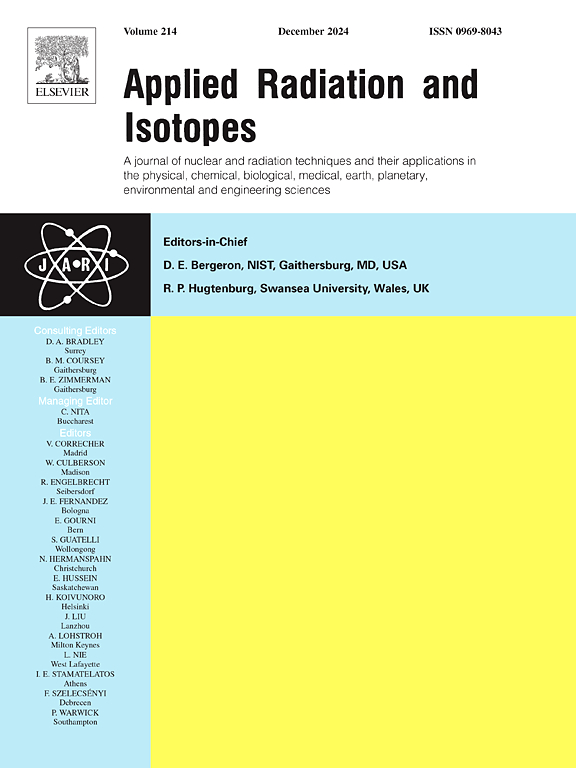Relative biological effectiveness of an accelerator-based BNCT system coupled to a solid-state lithium target: two different approaches for neutron beams
IF 1.6
3区 工程技术
Q3 CHEMISTRY, INORGANIC & NUCLEAR
引用次数: 0
Abstract
The relative biological effectiveness (RBE) of neutrons in neutron beams is crucial for the clinical implementation of accelerator-based boron neutron capture therapy (BNCT) systems. The RBE was quantified by comparing the doses required to achieve a 10 % cell survival fraction (D10) between reference radiation (photons) and neutrons. However, in accelerator-based BNCT, the neutron beam includes not only neutrons but also contaminating gamma rays, making it essential to calculate the RBE of neutrons while accounting for the gamma-ray dose. The RBE of neutrons was calculated using a recently proposed method, which assumes that the interaction between neutrons and contaminating gamma rays is independent, and this was compared with the conventional method, which assumes that the interactions are not independent. These calculations were conducted in an accelerator-based BNCT system with a solid-state lithium target. A comparison was also performed by varying the representative beam parameters to validate the RBE values. Additionally, the photon isoeffective dose was implemented and compared with the RBE-weighted dose calculated from the two RBE values. Four cell lines (SAS, SCCVII, U87-MG, and NB1RGB) were used to assess the cell survival fraction (SF). The SF curves for neutrons and photons were derived using linear and linear-quadratic models, respectively, to calculate D10. For the four cell lines, the mean RBE value calculated using the conventional method was 1.9 (RBE1), while that calculated using the recent method was 2.0 (RBE2). Furthermore, when the photon isoeffective dose was calculated, it closely matched the RBE-weighted doses obtained using RBE1 and RBE2 from the four cell lines. This study also examined the impact of varying the ratio of contaminating gamma rays to neutron doses, a representative beam parameter, on RBE1 and RBE2. The RBE2 value remained independent of the ratio, whereas the RBE1 value increased with rising gamma-ray contamination. However, the two RBE values was comparable when the system was adequately designed for clinical BNCT use. Therefore, this study suggests that comparing the RBE values derived from the two different methods can confirm not only the validity of the RBE but also the representative beam parameters in accelerator-based BNCT.
基于加速器的BNCT系统与固态锂靶耦合的相对生物有效性:中子束的两种不同方法
中子束中中子的相对生物有效性(RBE)对于基于加速器的硼中子俘获治疗(BNCT)系统的临床应用至关重要。RBE是通过比较参考辐射(光子)和中子达到10%细胞存活率(D10)所需的剂量来量化的。然而,在基于加速器的 BNCT 中,中子束不仅包括中子,还包括污染性伽马射线,因此必须在计算伽马射线剂量的同时计算中子的 RBE。计算中子的 RBE 采用了最近提出的一种方法,该方法假定中子与污染伽马射线之间的相互作用是独立的,并与假定相互作用不独立的传统方法进行了比较。这些计算是在基于加速器的 BNCT 系统中使用固态锂靶进行的。还通过改变代表性射束参数进行了比较,以验证 RBE 值。此外,还采用了光子等效剂量,并与根据两个 RBE 值计算出的 RBE 加权剂量进行了比较。四种细胞系(SAS、SCCVII、U87-MG 和 NB1RGB)被用来评估细胞存活率(SF)。中子和光子的 SF 曲线分别采用线性和线性二次模型推导,以计算 D10。对于四种细胞系,使用传统方法计算出的平均 RBE 值为 1.9(RBE1),而使用最新方法计算出的平均 RBE 值为 2.0(RBE2)。此外,在计算光子等效剂量时,该剂量与四种细胞系使用 RBE1 和 RBE2 计算出的 RBE 加权剂量非常接近。这项研究还考察了改变伽马射线与中子污染剂量之比(一种代表性的光束参数)对 RBE1 和 RBE2 的影响。RBE2 值与比例无关,而 RBE1 值则随着伽马射线污染的增加而增加。不过,当系统设计得足以用于临床 BNCT 时,两个 RBE 值是相当的。因此,这项研究表明,比较两种不同方法得出的 RBE 值不仅可以确认 RBE 的有效性,还可以确认加速器 BNCT 中的代表性射束参数。
本文章由计算机程序翻译,如有差异,请以英文原文为准。
求助全文
约1分钟内获得全文
求助全文
来源期刊

Applied Radiation and Isotopes
工程技术-核科学技术
CiteScore
3.00
自引率
12.50%
发文量
406
审稿时长
13.5 months
期刊介绍:
Applied Radiation and Isotopes provides a high quality medium for the publication of substantial, original and scientific and technological papers on the development and peaceful application of nuclear, radiation and radionuclide techniques in chemistry, physics, biochemistry, biology, medicine, security, engineering and in the earth, planetary and environmental sciences, all including dosimetry. Nuclear techniques are defined in the broadest sense and both experimental and theoretical papers are welcome. They include the development and use of α- and β-particles, X-rays and γ-rays, neutrons and other nuclear particles and radiations from all sources, including radionuclides, synchrotron sources, cyclotrons and reactors and from the natural environment.
The journal aims to publish papers with significance to an international audience, containing substantial novelty and scientific impact. The Editors reserve the rights to reject, with or without external review, papers that do not meet these criteria.
Papers dealing with radiation processing, i.e., where radiation is used to bring about a biological, chemical or physical change in a material, should be directed to our sister journal Radiation Physics and Chemistry.
 求助内容:
求助内容: 应助结果提醒方式:
应助结果提醒方式:


